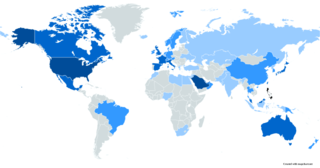Related Research Articles

An overseas Filipino is a person of full or partial Filipino origin—i.e., people who trace back their ancestry to the Philippines but living or residing outside the country. This term generally applies to both people of Filipino ancestry and citizens abroad. As of 2019, there were over 12 million Filipinos overseas.

A remittance is a non-commercial transfer of money by a foreign worker, a member of a diaspora community, or a citizen with familial ties abroad, for household income in their home country or homeland. Money sent home by migrants competes with international aid as one of the largest financial inflows to developing countries. Workers' remittances are a significant part of international capital flows, especially with regard to labor-exporting countries.

Overseas Filipino Worker (OFW) is a term often used to refer to Filipino migrant workers, people with Filipino citizenship who reside in another country for a limited period of employment. The number of these workers was roughly 1.77 million between April and September 2020. Of these, female workers comprised a larger portion, making up 59.6 percent, or 1.06 million. However, this number declined to 405.62 thousand between 2019 and 2020.
There are many Spanish people of Filipino ancestry, consisting of the descendants of early migrants from the Philippines to Spain, as well as more recent migrants. Some 200,000 Filipinos are estimated to live in Spain, including 37,000 expatriates from the Philippines living in Spain who do not hold Spanish citizenship.
Filipinos in the United Arab Emirates are migrants or descendants of the Filipinos living in the United Arab Emirates. 679,819 Filipinos live in the UAE, of which 450,000 live in Dubai, and they form 6.1% of the whole UAE population, and they form 21.3% of the population of Dubai. Dubai is home to the largest population of Filipinos in the UAE, followed by Abu Dhabi and Al Ain. In 2007, Filipinos in the UAE sent more than US$500 million in remittances back to the Philippines.
Filipinos in Kuwait are either migrants from or descendants of the Philippines living in Kuwait. As of 2020, there are roughly 241,000 of these Filipinos in Kuwait. Most people in the Filipino community are migrant workers, and approximately 60% of Filipinos in Kuwait are employed as domestic workers.

Filipinos in Saudi Arabia are migrants or descendants of the Philippines who live in Saudi Arabia. Saudi Arabia is currently the largest employer of Overseas Filipino Workers (OFWs), and has the largest Filipino population in the Middle East. Filipinos make up the fourth-largest group of foreigners in Saudi Arabia, and are the second-largest source of remittances to the Philippines.
Filipinos in Qatar are either migrants or descendants of the Philippines living in Qatar. Around 260,000 Filipinos live in Qatar, and frequently work in construction and service jobs. As of early 2017, Filipinos are estimated to be the fourth-largest group of foreign workers in Qatar, after Indians, Nepalis and Bangladeshis. With 56,277 Filipinos arriving between January and November 2008, Qatar is the third-largest destination of Overseas Filipino Workers (OFW's) in the Middle East after the United Arab Emirates and Saudi Arabia, and also the fourth-largest destination of OFW's worldwide. Despite this, and the removal of the Philippines from the pandemic-related travel-restriction "Red List" in August, 2022, Philippine nationals are unable to apply for Qatar tourist visas.
Filipinos in Switzerland consist of migrants from the Philippines to Switzerland and their descendants.
The labor migration policy of the Philippine government allows and encourages emigration. The Department of Foreign Affairs, which is one of the government's arms of emigration, grants Filipinos passports that allow entry to foreign countries. In 1952, the Philippine government formed the Philippine Overseas Employment Administration (POEA) as the agency responsible for opening the benefits of the overseas employment program. In 1995, it enacted the Migrant Workers and Overseas Filipino Act in order to "institute the policies of overseas employment and establish a higher standard of protection and promotion of the welfare of migrant workers and their families and overseas Filipinos in distress." In 2022, the Department of Migrant Workers was formed, incorporating the POEA with its functions and mandate becoming the backbone of the new executive department.

The Philippine Overseas Employment Administration was an agency of the government of the Philippines responsible for opening the benefits of the overseas employment program of the Philippines. It is the main government agency assigned to monitor and supervise overseas recruitment and manning agencies in the Philippines. The POEA's office is located at EDSA corner Ortigas Avenue, Mandaluyong, Philippines.
Filipinos in Oman are either migrants or descendants of the Philippines living in Oman. As of 2011, there are between 40,000 and 46,000 of these Filipinos in Oman. A large destination for Overseas Filipino workers (OFWs), Oman was the only Middle Eastern nation included on the Philippine Overseas Employment Administration's list of nations safe for OFWs. The country still holds the title up to this day.
Filipinos in Bahrain are either migrants or descendants of the Philippines living in Bahrain. As of 2012, there are approximately 40,000 of these Filipinos in Bahrain.
Filipinos in Norway comprise expatriates and migrants from the Philippines to Norway and their locally-born descendants. As of 2019, there are approximately 25,000 Filipinos in Norway.

Italy–Philippines relations are the interstate and bilateral relations between Italy and the Philippines. The bilateral relations between Italy and the Philippines was established on 9 July 1947.

Philippines–South Africa relations refers to bilateral relations between the Philippines and South Africa. Relations were established in November 1993, with the Philippines maintaining an embassy in Pretoria and South Africa having an embassy in Manila. Relations between the two states remains strong on both bilateral and multilateral levels, and the most influential in some international organisations including the Non-Aligned Movement and the Group of 77.
In early 2018, Kuwait and the Philippines were embroiled in a diplomatic crisis over the situation of Filipino migrant workers in the gulf country.

Overseas Filipinos, including Filipino migrant workers outside the Philippines, have been affected by the COVID-19 pandemic. As of June 1, 2021, there have been 19,765 confirmed COVID-19 cases of Filipino citizens residing outside the Philippines with 12,037 recoveries and 1,194 deaths. The official count from the Department of Foreign Affairs (DFA) on the cases of overseas Filipinos is not included in the national tally of the Philippine government. Repatriates on the other hand are included in the national tally of the Department of Health (DOH) but are listed separately from regional counts.

The Department of Migrant Workers is the executive department of the Philippine government responsible for the protection of the rights and promote the welfare of Overseas Filipino Workers (OFW) and their families. The department was created under the Department of Migrant Workers Act that was signed by President Rodrigo Duterte on December 30, 2021. The functions and mandate of the Philippine Overseas Employment Administration (POEA) will serve as the backbone of the department and absorbing the seven offices of the Department of Labor and Employment (DOLE) and Department of Foreign Affairs (DFA) namely the Office of the Undersecretary for Migrant Workers' Affairs (OUMWA) of the DFA, Philippine Overseas Labor Office (POLO), International Labor Affairs Bureau (ILAB), National Reintegration Center for OFWs (NRCO) and the National Maritime Polytechnic (NMP) of the DOLE. The Overseas Workers Welfare Administration will serve as its attached agency and the DMW secretary will serve as the concurrent chairperson of OWWA.
References
- 1 2 "Filipino Migration to Europe: Country Profiles". CFMW. Archived from the original on 14 August 2011. Retrieved 19 January 2009.
- 1 2 3 4 "Filipino migration" (PDF). UN. Archived from the original (PDF) on 24 July 2014. Retrieved 7 December 2012.
- ↑ Dancel, Joshua (25 September 2002). "Get amnesty before Italy kicks you out, OFWs told". Sun Star Manila. Archived from the original on 20 April 2009. Retrieved 19 January 2009.
- ↑ "80,000 more Filipinos in Italy in 2008". ABS CBN News. 9 August 2009. Retrieved 7 December 2012.
- 1 2 Uy, Veronica (18 December 2007). "More jobs for Filipinos in Italy, says DoLE". Global Nation. Archived from the original on 22 February 2008. Retrieved 19 January 2009.
- ↑ "PGMA's Italy visit brightens hope for early accord on 3 RP proposals on Filipino workers". Philippine Department of Foreign Affairs. 2006. Archived from the original on January 8, 2009. Retrieved 19 January 2009.
- ↑ "Life in Italy is no Dolce Vita". Isis International. 8 May 2007. Retrieved 7 December 2012.
- ↑ "OFWs in Italy receive 2 unexpected gifts during President's visit". PLDT. 2007. Archived from the original on 13 December 2009. Retrieved 19 January 2009.
- ↑ "International research institute studies Filipino Women's remittances from Italy". PhilFortune. 17 April 2007. Retrieved 19 January 2009.
- 1 2 Conde, Carlos (16 December 2005). "Filipinos count cost of remittance society". IHT. Archived from the original on 19 November 2008. Retrieved 19 January 2009.
- ↑ Rimando, Lala (15 December 2008). "Global slowdown drags October remittances to weakest pace". ABS-CBN News. Retrieved 19 January 2009.; Arnaldo Mauri, Remittances from Italy to developing countries, Quaderni n. 12, 1996, Abstract
